Equality and Diversity in the Workplace: Unilever Project Report
VerifiedAdded on 2023/01/18
|28
|6017
|89
Project
AI Summary
This project report delves into the critical aspects of managing equality and diversity in the workplace, focusing on Unilever as a case study. The report commences with an introduction outlining the significance of business projects and equality and diversity, followed by the formulation of project aims and objectives, which are centered on understanding the challenges organizations face in maintaining a diverse and equitable workforce. A comprehensive project management plan is developed, encompassing cost, scope, time, quality, communication, risk, and resource management. The project then proceeds with the creation of a work breakdown structure and a Gantt chart to establish clear timelines and stages for project completion. Small-scale research is conducted, employing both primary and secondary research methods to gather data and insights. The findings are presented using appropriate tools, and recommendations are communicated based on data analysis, leading to valid conclusions. The report concludes with a reflection on the value of the project and the learning acquired throughout the process. The project aims to ascertain the distinct challenges faced by organizations in maintaining workplace equality and diversity, offering insights and actionable strategies for improvement.

Managing a Successful
Business Project
Business Project
Paraphrase This Document
Need a fresh take? Get an instant paraphrase of this document with our AI Paraphraser
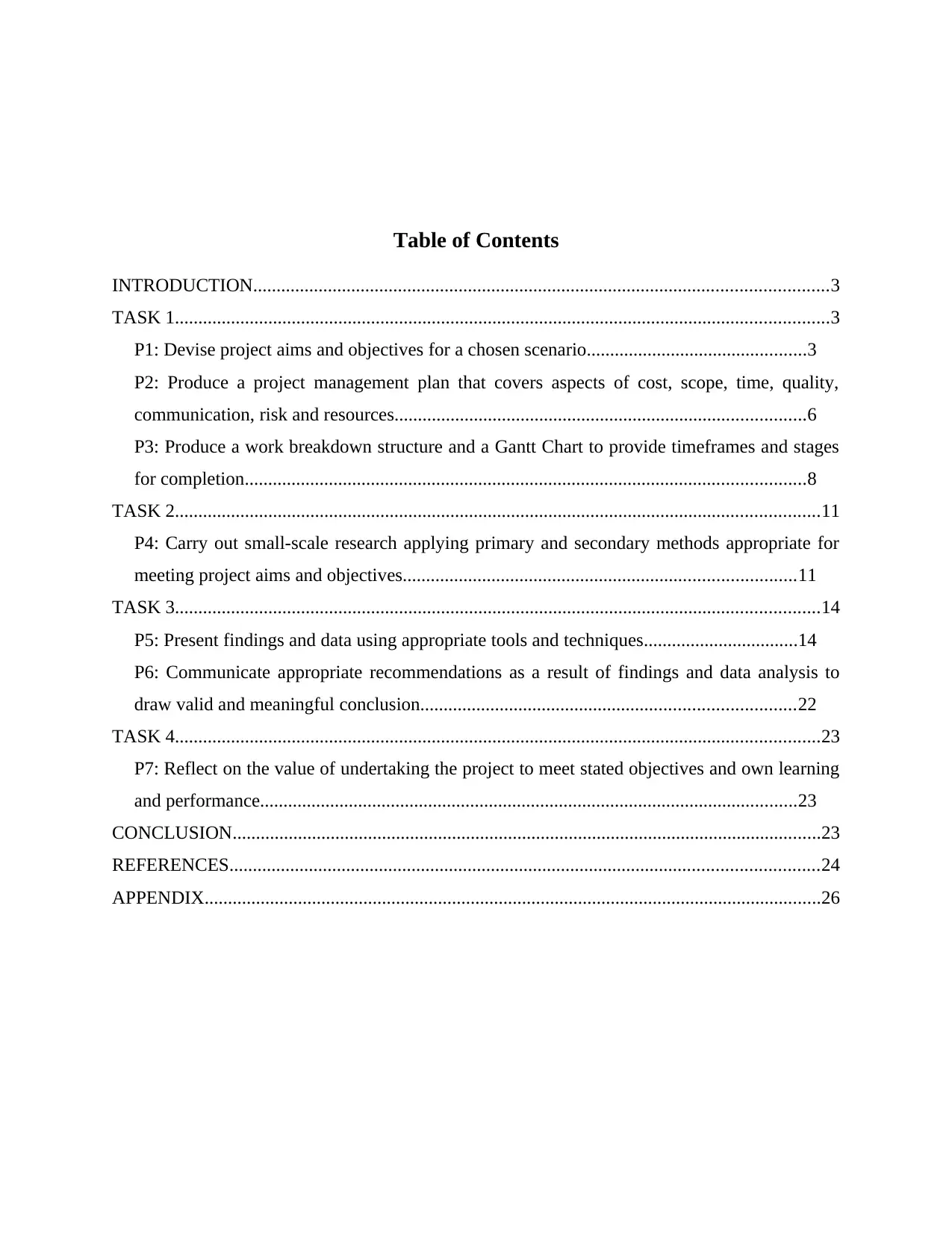
Table of Contents
INTRODUCTION...........................................................................................................................3
TASK 1............................................................................................................................................3
P1: Devise project aims and objectives for a chosen scenario...............................................3
P2: Produce a project management plan that covers aspects of cost, scope, time, quality,
communication, risk and resources........................................................................................6
P3: Produce a work breakdown structure and a Gantt Chart to provide timeframes and stages
for completion........................................................................................................................8
TASK 2..........................................................................................................................................11
P4: Carry out small-scale research applying primary and secondary methods appropriate for
meeting project aims and objectives....................................................................................11
TASK 3..........................................................................................................................................14
P5: Present findings and data using appropriate tools and techniques.................................14
P6: Communicate appropriate recommendations as a result of findings and data analysis to
draw valid and meaningful conclusion................................................................................22
TASK 4..........................................................................................................................................23
P7: Reflect on the value of undertaking the project to meet stated objectives and own learning
and performance...................................................................................................................23
CONCLUSION..............................................................................................................................23
REFERENCES..............................................................................................................................24
APPENDIX....................................................................................................................................26
INTRODUCTION...........................................................................................................................3
TASK 1............................................................................................................................................3
P1: Devise project aims and objectives for a chosen scenario...............................................3
P2: Produce a project management plan that covers aspects of cost, scope, time, quality,
communication, risk and resources........................................................................................6
P3: Produce a work breakdown structure and a Gantt Chart to provide timeframes and stages
for completion........................................................................................................................8
TASK 2..........................................................................................................................................11
P4: Carry out small-scale research applying primary and secondary methods appropriate for
meeting project aims and objectives....................................................................................11
TASK 3..........................................................................................................................................14
P5: Present findings and data using appropriate tools and techniques.................................14
P6: Communicate appropriate recommendations as a result of findings and data analysis to
draw valid and meaningful conclusion................................................................................22
TASK 4..........................................................................................................................................23
P7: Reflect on the value of undertaking the project to meet stated objectives and own learning
and performance...................................................................................................................23
CONCLUSION..............................................................................................................................23
REFERENCES..............................................................................................................................24
APPENDIX....................................................................................................................................26
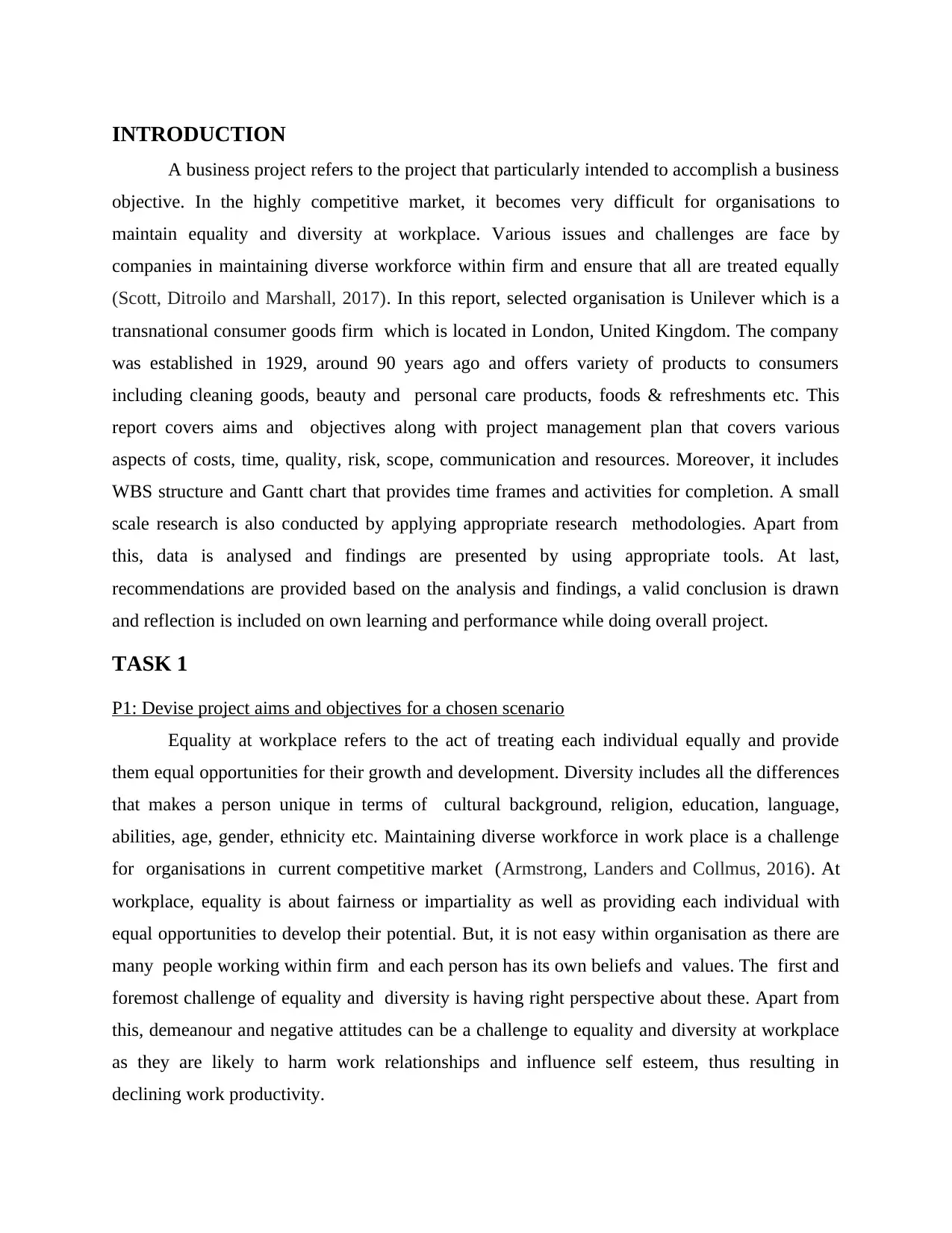
INTRODUCTION
A business project refers to the project that particularly intended to accomplish a business
objective. In the highly competitive market, it becomes very difficult for organisations to
maintain equality and diversity at workplace. Various issues and challenges are face by
companies in maintaining diverse workforce within firm and ensure that all are treated equally
(Scott, Ditroilo and Marshall, 2017). In this report, selected organisation is Unilever which is a
transnational consumer goods firm which is located in London, United Kingdom. The company
was established in 1929, around 90 years ago and offers variety of products to consumers
including cleaning goods, beauty and personal care products, foods & refreshments etc. This
report covers aims and objectives along with project management plan that covers various
aspects of costs, time, quality, risk, scope, communication and resources. Moreover, it includes
WBS structure and Gantt chart that provides time frames and activities for completion. A small
scale research is also conducted by applying appropriate research methodologies. Apart from
this, data is analysed and findings are presented by using appropriate tools. At last,
recommendations are provided based on the analysis and findings, a valid conclusion is drawn
and reflection is included on own learning and performance while doing overall project.
TASK 1
P1: Devise project aims and objectives for a chosen scenario
Equality at workplace refers to the act of treating each individual equally and provide
them equal opportunities for their growth and development. Diversity includes all the differences
that makes a person unique in terms of cultural background, religion, education, language,
abilities, age, gender, ethnicity etc. Maintaining diverse workforce in work place is a challenge
for organisations in current competitive market (Armstrong, Landers and Collmus, 2016). At
workplace, equality is about fairness or impartiality as well as providing each individual with
equal opportunities to develop their potential. But, it is not easy within organisation as there are
many people working within firm and each person has its own beliefs and values. The first and
foremost challenge of equality and diversity is having right perspective about these. Apart from
this, demeanour and negative attitudes can be a challenge to equality and diversity at workplace
as they are likely to harm work relationships and influence self esteem, thus resulting in
declining work productivity.
A business project refers to the project that particularly intended to accomplish a business
objective. In the highly competitive market, it becomes very difficult for organisations to
maintain equality and diversity at workplace. Various issues and challenges are face by
companies in maintaining diverse workforce within firm and ensure that all are treated equally
(Scott, Ditroilo and Marshall, 2017). In this report, selected organisation is Unilever which is a
transnational consumer goods firm which is located in London, United Kingdom. The company
was established in 1929, around 90 years ago and offers variety of products to consumers
including cleaning goods, beauty and personal care products, foods & refreshments etc. This
report covers aims and objectives along with project management plan that covers various
aspects of costs, time, quality, risk, scope, communication and resources. Moreover, it includes
WBS structure and Gantt chart that provides time frames and activities for completion. A small
scale research is also conducted by applying appropriate research methodologies. Apart from
this, data is analysed and findings are presented by using appropriate tools. At last,
recommendations are provided based on the analysis and findings, a valid conclusion is drawn
and reflection is included on own learning and performance while doing overall project.
TASK 1
P1: Devise project aims and objectives for a chosen scenario
Equality at workplace refers to the act of treating each individual equally and provide
them equal opportunities for their growth and development. Diversity includes all the differences
that makes a person unique in terms of cultural background, religion, education, language,
abilities, age, gender, ethnicity etc. Maintaining diverse workforce in work place is a challenge
for organisations in current competitive market (Armstrong, Landers and Collmus, 2016). At
workplace, equality is about fairness or impartiality as well as providing each individual with
equal opportunities to develop their potential. But, it is not easy within organisation as there are
many people working within firm and each person has its own beliefs and values. The first and
foremost challenge of equality and diversity is having right perspective about these. Apart from
this, demeanour and negative attitudes can be a challenge to equality and diversity at workplace
as they are likely to harm work relationships and influence self esteem, thus resulting in
declining work productivity.
⊘ This is a preview!⊘
Do you want full access?
Subscribe today to unlock all pages.

Trusted by 1+ million students worldwide
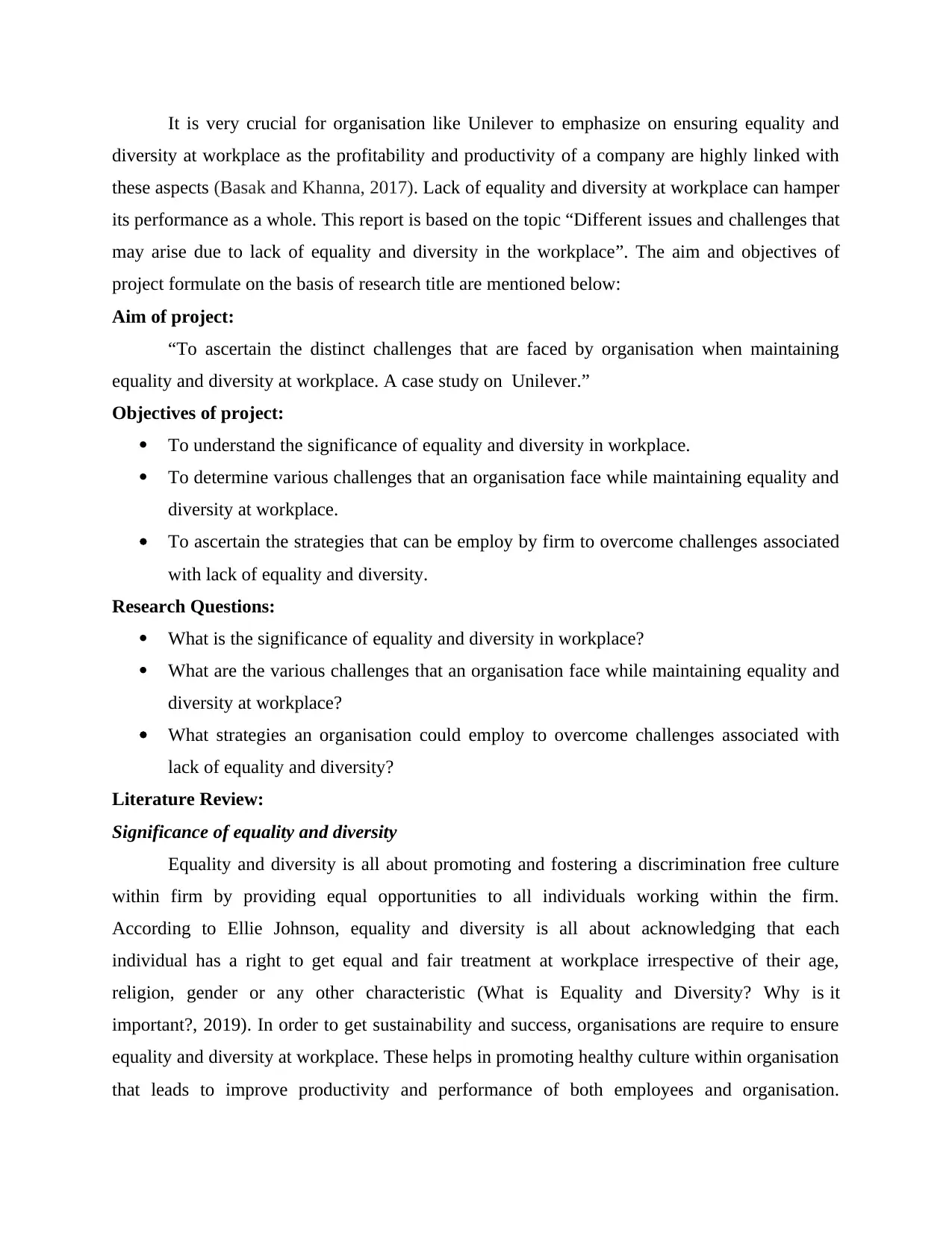
It is very crucial for organisation like Unilever to emphasize on ensuring equality and
diversity at workplace as the profitability and productivity of a company are highly linked with
these aspects (Basak and Khanna, 2017). Lack of equality and diversity at workplace can hamper
its performance as a whole. This report is based on the topic “Different issues and challenges that
may arise due to lack of equality and diversity in the workplace”. The aim and objectives of
project formulate on the basis of research title are mentioned below:
Aim of project:
“To ascertain the distinct challenges that are faced by organisation when maintaining
equality and diversity at workplace. A case study on Unilever.”
Objectives of project:
To understand the significance of equality and diversity in workplace.
To determine various challenges that an organisation face while maintaining equality and
diversity at workplace.
To ascertain the strategies that can be employ by firm to overcome challenges associated
with lack of equality and diversity.
Research Questions:
What is the significance of equality and diversity in workplace?
What are the various challenges that an organisation face while maintaining equality and
diversity at workplace?
What strategies an organisation could employ to overcome challenges associated with
lack of equality and diversity?
Literature Review:
Significance of equality and diversity
Equality and diversity is all about promoting and fostering a discrimination free culture
within firm by providing equal opportunities to all individuals working within the firm.
According to Ellie Johnson, equality and diversity is all about acknowledging that each
individual has a right to get equal and fair treatment at workplace irrespective of their age,
religion, gender or any other characteristic (What is Equality and Diversity? Why is it
important?, 2019). In order to get sustainability and success, organisations are require to ensure
equality and diversity at workplace. These helps in promoting healthy culture within organisation
that leads to improve productivity and performance of both employees and organisation.
diversity at workplace as the profitability and productivity of a company are highly linked with
these aspects (Basak and Khanna, 2017). Lack of equality and diversity at workplace can hamper
its performance as a whole. This report is based on the topic “Different issues and challenges that
may arise due to lack of equality and diversity in the workplace”. The aim and objectives of
project formulate on the basis of research title are mentioned below:
Aim of project:
“To ascertain the distinct challenges that are faced by organisation when maintaining
equality and diversity at workplace. A case study on Unilever.”
Objectives of project:
To understand the significance of equality and diversity in workplace.
To determine various challenges that an organisation face while maintaining equality and
diversity at workplace.
To ascertain the strategies that can be employ by firm to overcome challenges associated
with lack of equality and diversity.
Research Questions:
What is the significance of equality and diversity in workplace?
What are the various challenges that an organisation face while maintaining equality and
diversity at workplace?
What strategies an organisation could employ to overcome challenges associated with
lack of equality and diversity?
Literature Review:
Significance of equality and diversity
Equality and diversity is all about promoting and fostering a discrimination free culture
within firm by providing equal opportunities to all individuals working within the firm.
According to Ellie Johnson, equality and diversity is all about acknowledging that each
individual has a right to get equal and fair treatment at workplace irrespective of their age,
religion, gender or any other characteristic (What is Equality and Diversity? Why is it
important?, 2019). In order to get sustainability and success, organisations are require to ensure
equality and diversity at workplace. These helps in promoting healthy culture within organisation
that leads to improve productivity and performance of both employees and organisation.
Paraphrase This Document
Need a fresh take? Get an instant paraphrase of this document with our AI Paraphraser
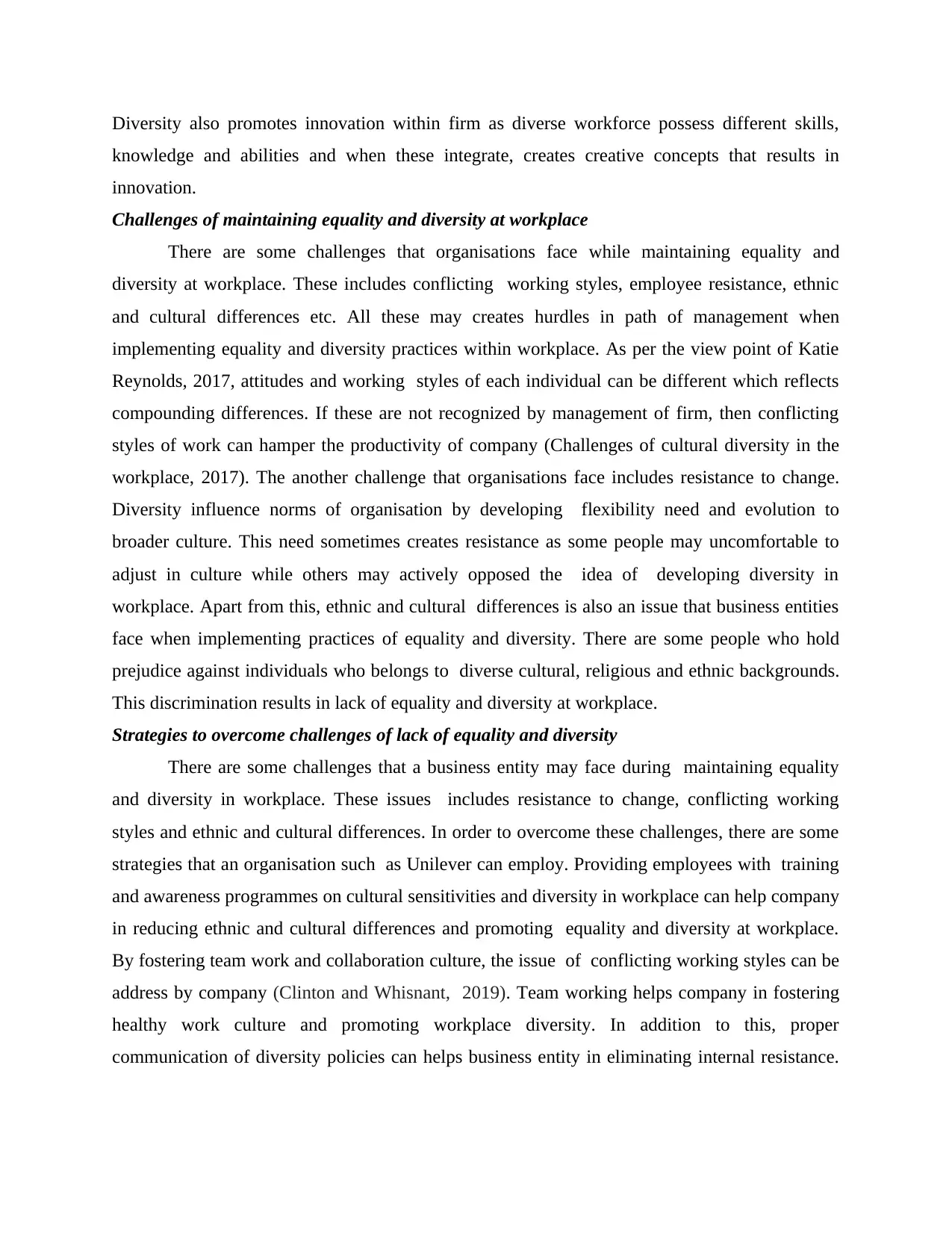
Diversity also promotes innovation within firm as diverse workforce possess different skills,
knowledge and abilities and when these integrate, creates creative concepts that results in
innovation.
Challenges of maintaining equality and diversity at workplace
There are some challenges that organisations face while maintaining equality and
diversity at workplace. These includes conflicting working styles, employee resistance, ethnic
and cultural differences etc. All these may creates hurdles in path of management when
implementing equality and diversity practices within workplace. As per the view point of Katie
Reynolds, 2017, attitudes and working styles of each individual can be different which reflects
compounding differences. If these are not recognized by management of firm, then conflicting
styles of work can hamper the productivity of company (Challenges of cultural diversity in the
workplace, 2017). The another challenge that organisations face includes resistance to change.
Diversity influence norms of organisation by developing flexibility need and evolution to
broader culture. This need sometimes creates resistance as some people may uncomfortable to
adjust in culture while others may actively opposed the idea of developing diversity in
workplace. Apart from this, ethnic and cultural differences is also an issue that business entities
face when implementing practices of equality and diversity. There are some people who hold
prejudice against individuals who belongs to diverse cultural, religious and ethnic backgrounds.
This discrimination results in lack of equality and diversity at workplace.
Strategies to overcome challenges of lack of equality and diversity
There are some challenges that a business entity may face during maintaining equality
and diversity in workplace. These issues includes resistance to change, conflicting working
styles and ethnic and cultural differences. In order to overcome these challenges, there are some
strategies that an organisation such as Unilever can employ. Providing employees with training
and awareness programmes on cultural sensitivities and diversity in workplace can help company
in reducing ethnic and cultural differences and promoting equality and diversity at workplace.
By fostering team work and collaboration culture, the issue of conflicting working styles can be
address by company (Clinton and Whisnant, 2019). Team working helps company in fostering
healthy work culture and promoting workplace diversity. In addition to this, proper
communication of diversity policies can helps business entity in eliminating internal resistance.
knowledge and abilities and when these integrate, creates creative concepts that results in
innovation.
Challenges of maintaining equality and diversity at workplace
There are some challenges that organisations face while maintaining equality and
diversity at workplace. These includes conflicting working styles, employee resistance, ethnic
and cultural differences etc. All these may creates hurdles in path of management when
implementing equality and diversity practices within workplace. As per the view point of Katie
Reynolds, 2017, attitudes and working styles of each individual can be different which reflects
compounding differences. If these are not recognized by management of firm, then conflicting
styles of work can hamper the productivity of company (Challenges of cultural diversity in the
workplace, 2017). The another challenge that organisations face includes resistance to change.
Diversity influence norms of organisation by developing flexibility need and evolution to
broader culture. This need sometimes creates resistance as some people may uncomfortable to
adjust in culture while others may actively opposed the idea of developing diversity in
workplace. Apart from this, ethnic and cultural differences is also an issue that business entities
face when implementing practices of equality and diversity. There are some people who hold
prejudice against individuals who belongs to diverse cultural, religious and ethnic backgrounds.
This discrimination results in lack of equality and diversity at workplace.
Strategies to overcome challenges of lack of equality and diversity
There are some challenges that a business entity may face during maintaining equality
and diversity in workplace. These issues includes resistance to change, conflicting working
styles and ethnic and cultural differences. In order to overcome these challenges, there are some
strategies that an organisation such as Unilever can employ. Providing employees with training
and awareness programmes on cultural sensitivities and diversity in workplace can help company
in reducing ethnic and cultural differences and promoting equality and diversity at workplace.
By fostering team work and collaboration culture, the issue of conflicting working styles can be
address by company (Clinton and Whisnant, 2019). Team working helps company in fostering
healthy work culture and promoting workplace diversity. In addition to this, proper
communication of diversity policies can helps business entity in eliminating internal resistance.

Aware people regarding benefits of equality and diversity can helps company in gaining support
from employees in maintaining discrimination free workplace.
P2: Produce a project management plan that covers aspects of cost, scope, time, quality,
communication, risk and resources
Project management plan is characterised as a formal report that includes all the phases of
project and their details. This document depicts about how a project is executed, managed,
monitored and controlled (Crane and Matten, 2016). This research project is about different
issues that may arise due to lack of equality and diversity within workplace. In order to ensure
successful completion of all the activities of project, a project management plan is prepared that
defines project needs as well as supports in addressing those effectively. The plan includes
various aspects such as time, scope, cost, quality, resources, risk and communication which are
mentioned below in context of project:
Cost Cost is the value or the amount of money that is incurred by an institution or
business entity for gaining effective results. For successful completion of this
particular project, the cost incurred by researcher is £5,000. There are some
costs that are associated with this project which are mentioned below:
Cost breakdown of Project:
Investment £600
Expertise £400
Research & Development cost £650
Employees Training £850
Resources for implementing equality and diversity £1400
Cost of executing changes in workplace £1100
Total £5000
Scope This aspect determines the future value of project and includes all the aspects
covered in project (Drews and Van den Bergh, 2016). This research has
wider scope as it supports investigator in getting clear understanding
regarding importance of equality and diversity at workplace, challenges
from employees in maintaining discrimination free workplace.
P2: Produce a project management plan that covers aspects of cost, scope, time, quality,
communication, risk and resources
Project management plan is characterised as a formal report that includes all the phases of
project and their details. This document depicts about how a project is executed, managed,
monitored and controlled (Crane and Matten, 2016). This research project is about different
issues that may arise due to lack of equality and diversity within workplace. In order to ensure
successful completion of all the activities of project, a project management plan is prepared that
defines project needs as well as supports in addressing those effectively. The plan includes
various aspects such as time, scope, cost, quality, resources, risk and communication which are
mentioned below in context of project:
Cost Cost is the value or the amount of money that is incurred by an institution or
business entity for gaining effective results. For successful completion of this
particular project, the cost incurred by researcher is £5,000. There are some
costs that are associated with this project which are mentioned below:
Cost breakdown of Project:
Investment £600
Expertise £400
Research & Development cost £650
Employees Training £850
Resources for implementing equality and diversity £1400
Cost of executing changes in workplace £1100
Total £5000
Scope This aspect determines the future value of project and includes all the aspects
covered in project (Drews and Van den Bergh, 2016). This research has
wider scope as it supports investigator in getting clear understanding
regarding importance of equality and diversity at workplace, challenges
⊘ This is a preview!⊘
Do you want full access?
Subscribe today to unlock all pages.

Trusted by 1+ million students worldwide

associated with it and strategies to overcome those challenges. It further
supports in ascertaining the benefits of having equality and diversity at
workplace. In future, this project supports in conducting further study on
topic.
Time This aspect is associated with constant progress of events which happens in
an ostensibly irreversible sequence from past to future. Time is one of the
significant aspect in research that demonstrates the starting and finishing
time of project. For successful completion of this research project, the
required time by researcher is approximately 4 months (Durlak, 2015).
Quality This is a subjective attribute of research project whose meaning is vary by
person to person. This is a crucial aspect that is considered by researchers in
order to ensure accurate outcomes. Appropriate methods are used by
researcher in this project for collecting data including observation,
questionnaire. This assists researcher in ensuring the quality of research.
Communication It is the way of communicating information to others by utilizing signs and
symbols. Researcher use some communication tools for conveying the
information regarding research project to team members. Telephones and e-
mails are the tools that are utilized by investigator for exchanging
information.
Risk This aspect is related to the uncertainty that is associated with the project
that may brings deviation in the actual outcome. The main risks associated
with this project includes cost and time. The project effectiveness may be
hindered by lack of time and financial resource as these may leads to delay
in completion of project (Flick, 2015).
Resources This is an important factor which is very necessary for attaining desired
outcome. In contains physical, technological, financial and human resources
that are essential for completion of project in successful manner. For
finishing this project successfully, adequate funds, technological tools like
internet and telephones, skilled team members and some other resources are
supports in ascertaining the benefits of having equality and diversity at
workplace. In future, this project supports in conducting further study on
topic.
Time This aspect is associated with constant progress of events which happens in
an ostensibly irreversible sequence from past to future. Time is one of the
significant aspect in research that demonstrates the starting and finishing
time of project. For successful completion of this research project, the
required time by researcher is approximately 4 months (Durlak, 2015).
Quality This is a subjective attribute of research project whose meaning is vary by
person to person. This is a crucial aspect that is considered by researchers in
order to ensure accurate outcomes. Appropriate methods are used by
researcher in this project for collecting data including observation,
questionnaire. This assists researcher in ensuring the quality of research.
Communication It is the way of communicating information to others by utilizing signs and
symbols. Researcher use some communication tools for conveying the
information regarding research project to team members. Telephones and e-
mails are the tools that are utilized by investigator for exchanging
information.
Risk This aspect is related to the uncertainty that is associated with the project
that may brings deviation in the actual outcome. The main risks associated
with this project includes cost and time. The project effectiveness may be
hindered by lack of time and financial resource as these may leads to delay
in completion of project (Flick, 2015).
Resources This is an important factor which is very necessary for attaining desired
outcome. In contains physical, technological, financial and human resources
that are essential for completion of project in successful manner. For
finishing this project successfully, adequate funds, technological tools like
internet and telephones, skilled team members and some other resources are
Paraphrase This Document
Need a fresh take? Get an instant paraphrase of this document with our AI Paraphraser
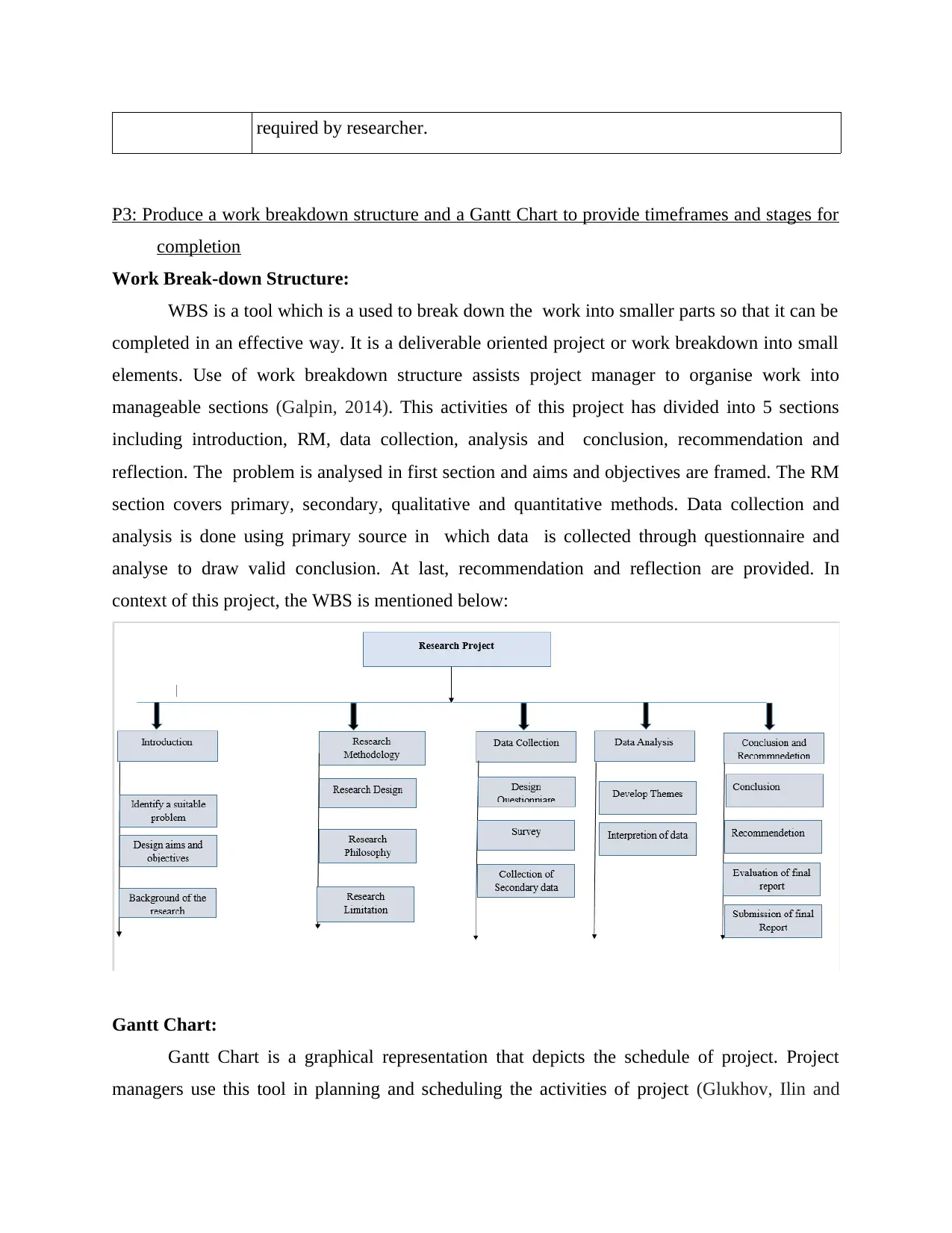
required by researcher.
P3: Produce a work breakdown structure and a Gantt Chart to provide timeframes and stages for
completion
Work Break-down Structure:
WBS is a tool which is a used to break down the work into smaller parts so that it can be
completed in an effective way. It is a deliverable oriented project or work breakdown into small
elements. Use of work breakdown structure assists project manager to organise work into
manageable sections (Galpin, 2014). This activities of this project has divided into 5 sections
including introduction, RM, data collection, analysis and conclusion, recommendation and
reflection. The problem is analysed in first section and aims and objectives are framed. The RM
section covers primary, secondary, qualitative and quantitative methods. Data collection and
analysis is done using primary source in which data is collected through questionnaire and
analyse to draw valid conclusion. At last, recommendation and reflection are provided. In
context of this project, the WBS is mentioned below:
Gantt Chart:
Gantt Chart is a graphical representation that depicts the schedule of project. Project
managers use this tool in planning and scheduling the activities of project (Glukhov, Ilin and
P3: Produce a work breakdown structure and a Gantt Chart to provide timeframes and stages for
completion
Work Break-down Structure:
WBS is a tool which is a used to break down the work into smaller parts so that it can be
completed in an effective way. It is a deliverable oriented project or work breakdown into small
elements. Use of work breakdown structure assists project manager to organise work into
manageable sections (Galpin, 2014). This activities of this project has divided into 5 sections
including introduction, RM, data collection, analysis and conclusion, recommendation and
reflection. The problem is analysed in first section and aims and objectives are framed. The RM
section covers primary, secondary, qualitative and quantitative methods. Data collection and
analysis is done using primary source in which data is collected through questionnaire and
analyse to draw valid conclusion. At last, recommendation and reflection are provided. In
context of this project, the WBS is mentioned below:
Gantt Chart:
Gantt Chart is a graphical representation that depicts the schedule of project. Project
managers use this tool in planning and scheduling the activities of project (Glukhov, Ilin and
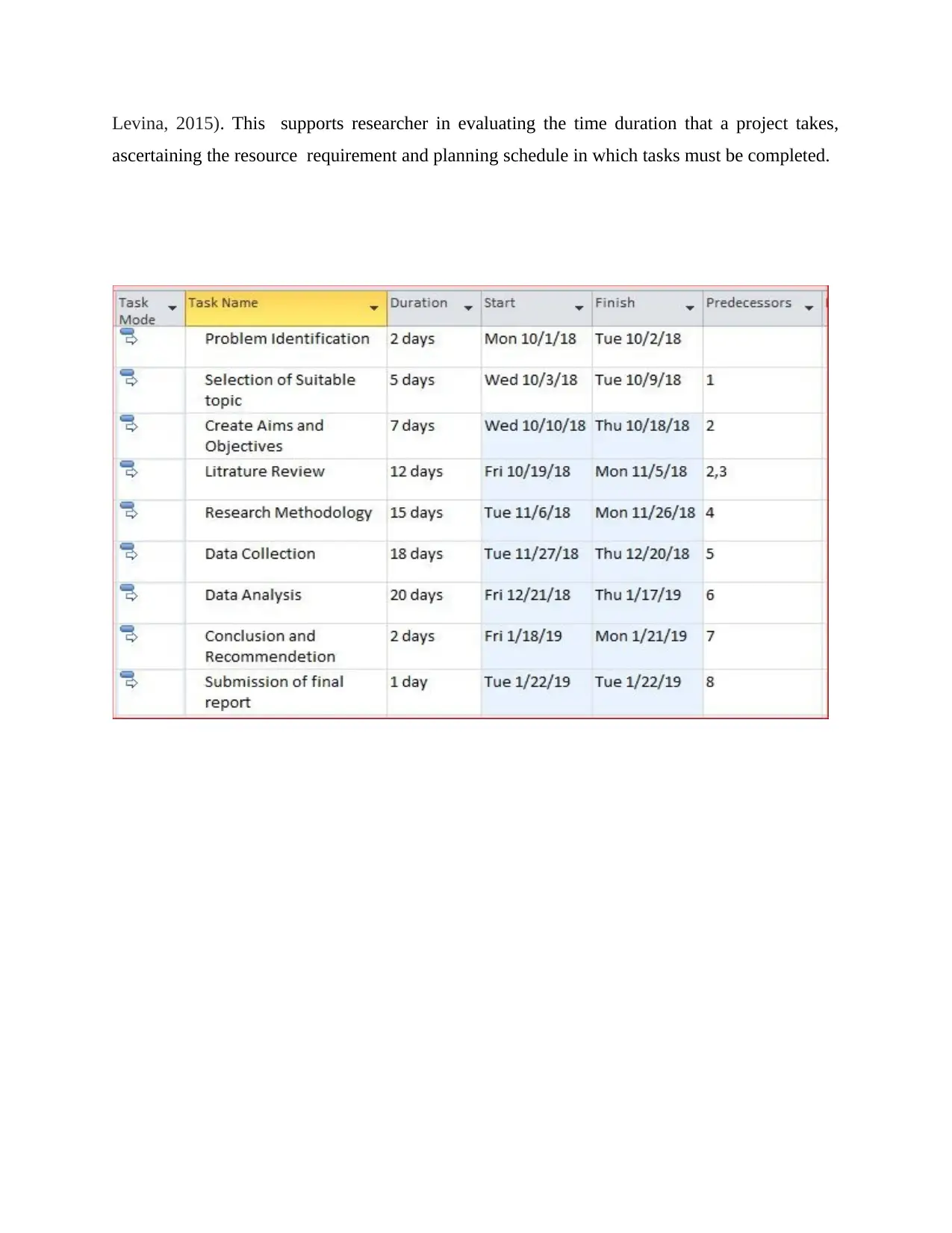
Levina, 2015). This supports researcher in evaluating the time duration that a project takes,
ascertaining the resource requirement and planning schedule in which tasks must be completed.
ascertaining the resource requirement and planning schedule in which tasks must be completed.
⊘ This is a preview!⊘
Do you want full access?
Subscribe today to unlock all pages.

Trusted by 1+ million students worldwide
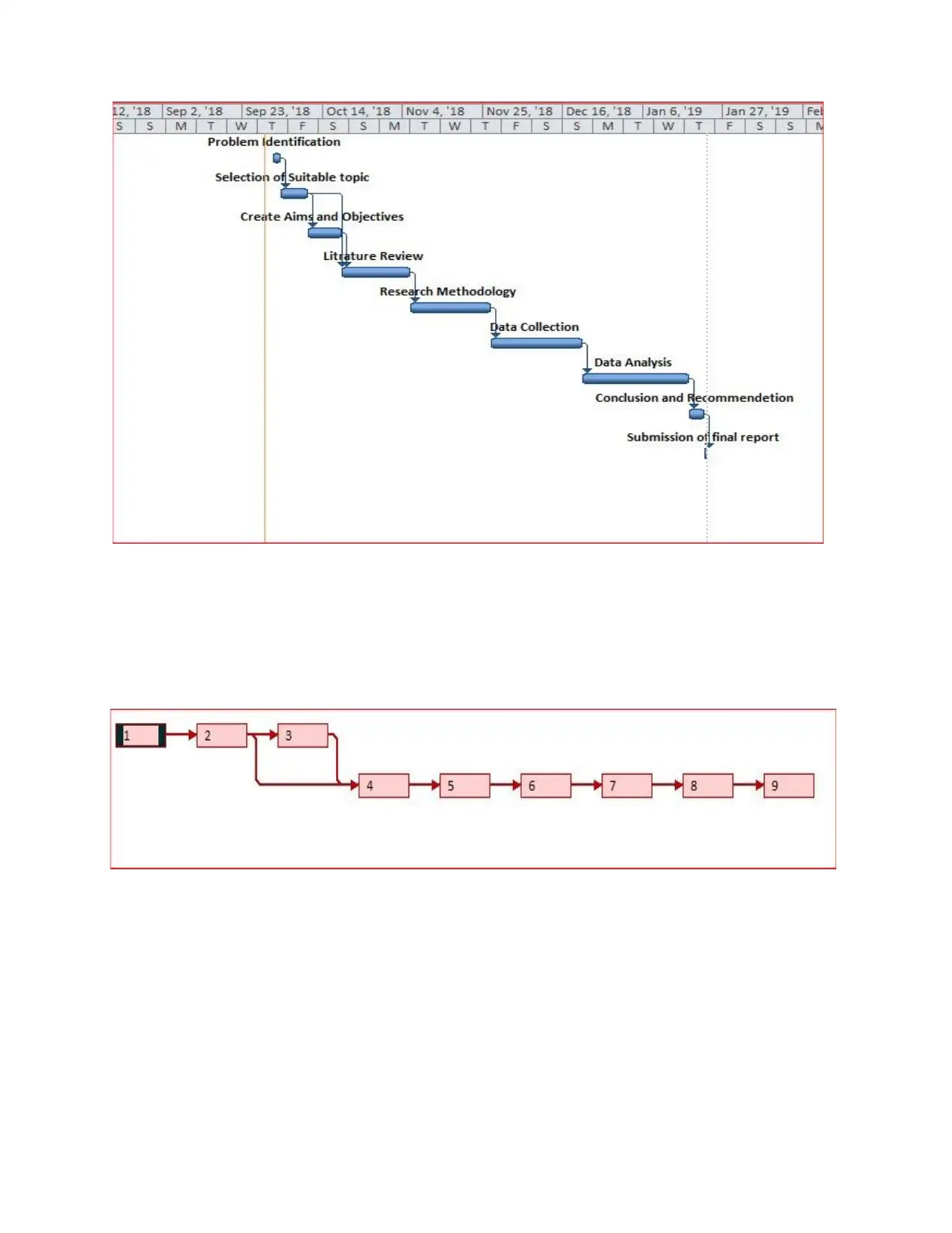
Paraphrase This Document
Need a fresh take? Get an instant paraphrase of this document with our AI Paraphraser
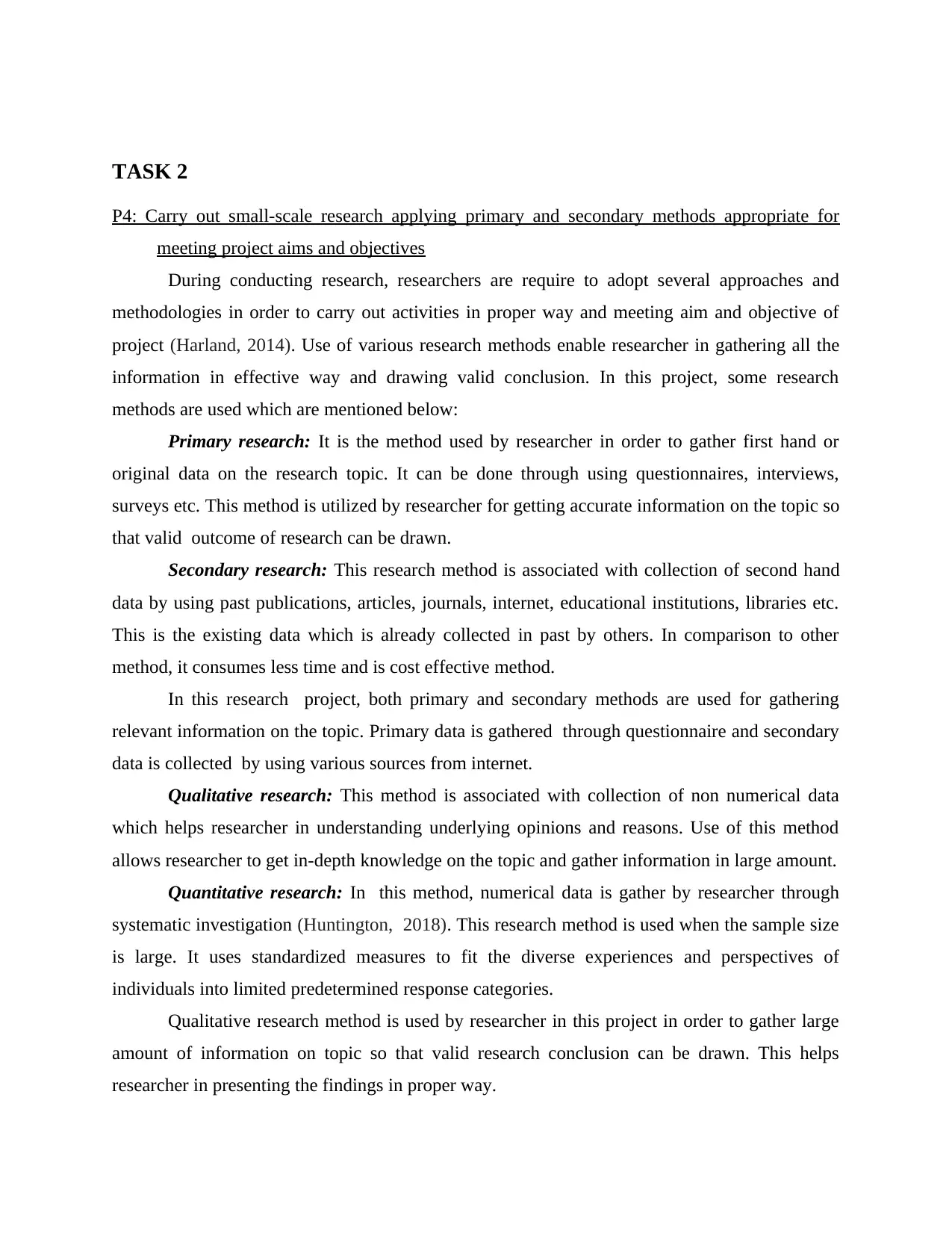
TASK 2
P4: Carry out small-scale research applying primary and secondary methods appropriate for
meeting project aims and objectives
During conducting research, researchers are require to adopt several approaches and
methodologies in order to carry out activities in proper way and meeting aim and objective of
project (Harland, 2014). Use of various research methods enable researcher in gathering all the
information in effective way and drawing valid conclusion. In this project, some research
methods are used which are mentioned below:
Primary research: It is the method used by researcher in order to gather first hand or
original data on the research topic. It can be done through using questionnaires, interviews,
surveys etc. This method is utilized by researcher for getting accurate information on the topic so
that valid outcome of research can be drawn.
Secondary research: This research method is associated with collection of second hand
data by using past publications, articles, journals, internet, educational institutions, libraries etc.
This is the existing data which is already collected in past by others. In comparison to other
method, it consumes less time and is cost effective method.
In this research project, both primary and secondary methods are used for gathering
relevant information on the topic. Primary data is gathered through questionnaire and secondary
data is collected by using various sources from internet.
Qualitative research: This method is associated with collection of non numerical data
which helps researcher in understanding underlying opinions and reasons. Use of this method
allows researcher to get in-depth knowledge on the topic and gather information in large amount.
Quantitative research: In this method, numerical data is gather by researcher through
systematic investigation (Huntington, 2018). This research method is used when the sample size
is large. It uses standardized measures to fit the diverse experiences and perspectives of
individuals into limited predetermined response categories.
Qualitative research method is used by researcher in this project in order to gather large
amount of information on topic so that valid research conclusion can be drawn. This helps
researcher in presenting the findings in proper way.
P4: Carry out small-scale research applying primary and secondary methods appropriate for
meeting project aims and objectives
During conducting research, researchers are require to adopt several approaches and
methodologies in order to carry out activities in proper way and meeting aim and objective of
project (Harland, 2014). Use of various research methods enable researcher in gathering all the
information in effective way and drawing valid conclusion. In this project, some research
methods are used which are mentioned below:
Primary research: It is the method used by researcher in order to gather first hand or
original data on the research topic. It can be done through using questionnaires, interviews,
surveys etc. This method is utilized by researcher for getting accurate information on the topic so
that valid outcome of research can be drawn.
Secondary research: This research method is associated with collection of second hand
data by using past publications, articles, journals, internet, educational institutions, libraries etc.
This is the existing data which is already collected in past by others. In comparison to other
method, it consumes less time and is cost effective method.
In this research project, both primary and secondary methods are used for gathering
relevant information on the topic. Primary data is gathered through questionnaire and secondary
data is collected by using various sources from internet.
Qualitative research: This method is associated with collection of non numerical data
which helps researcher in understanding underlying opinions and reasons. Use of this method
allows researcher to get in-depth knowledge on the topic and gather information in large amount.
Quantitative research: In this method, numerical data is gather by researcher through
systematic investigation (Huntington, 2018). This research method is used when the sample size
is large. It uses standardized measures to fit the diverse experiences and perspectives of
individuals into limited predetermined response categories.
Qualitative research method is used by researcher in this project in order to gather large
amount of information on topic so that valid research conclusion can be drawn. This helps
researcher in presenting the findings in proper way.
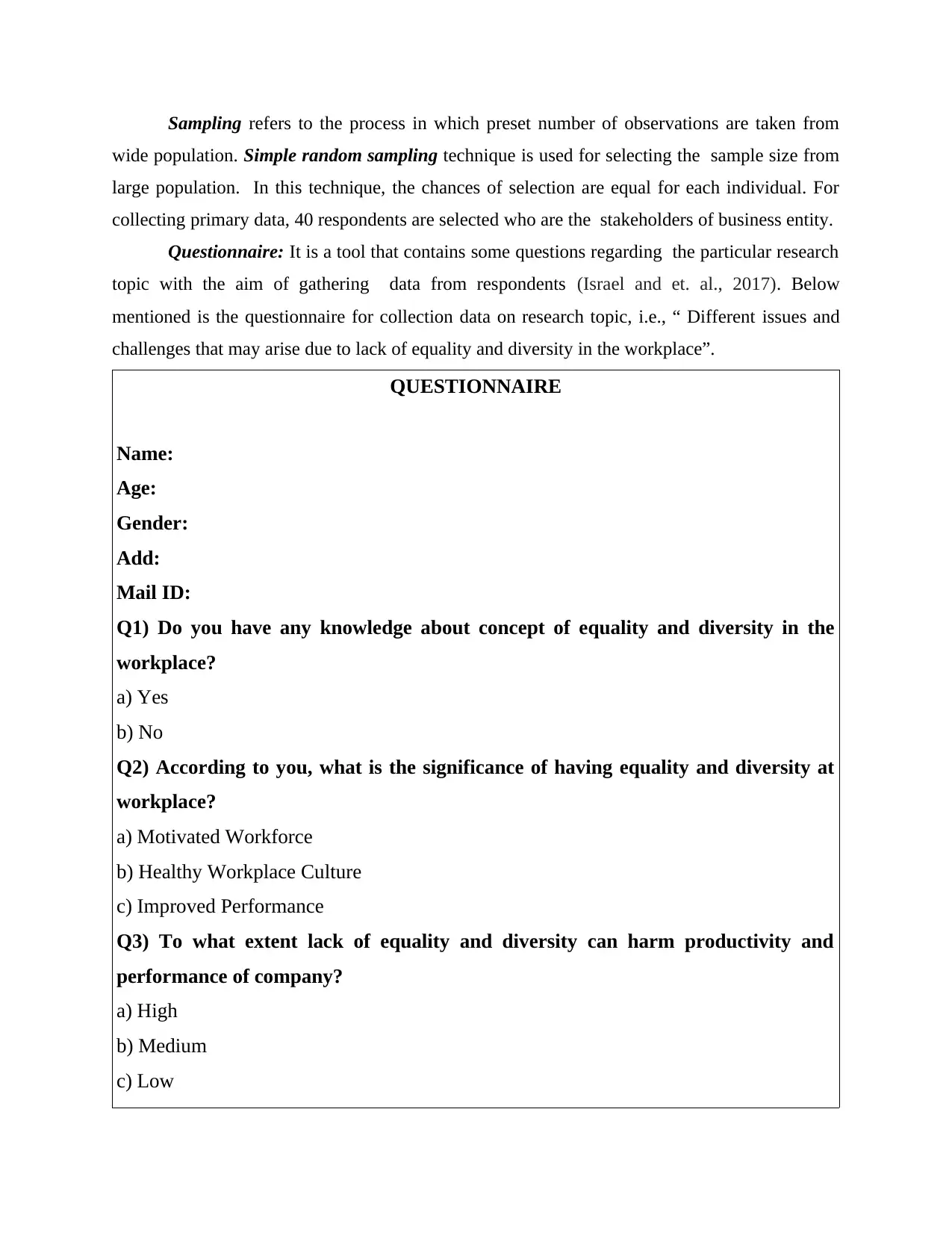
Sampling refers to the process in which preset number of observations are taken from
wide population. Simple random sampling technique is used for selecting the sample size from
large population. In this technique, the chances of selection are equal for each individual. For
collecting primary data, 40 respondents are selected who are the stakeholders of business entity.
Questionnaire: It is a tool that contains some questions regarding the particular research
topic with the aim of gathering data from respondents (Israel and et. al., 2017). Below
mentioned is the questionnaire for collection data on research topic, i.e., “ Different issues and
challenges that may arise due to lack of equality and diversity in the workplace”.
QUESTIONNAIRE
Name:
Age:
Gender:
Add:
Mail ID:
Q1) Do you have any knowledge about concept of equality and diversity in the
workplace?
a) Yes
b) No
Q2) According to you, what is the significance of having equality and diversity at
workplace?
a) Motivated Workforce
b) Healthy Workplace Culture
c) Improved Performance
Q3) To what extent lack of equality and diversity can harm productivity and
performance of company?
a) High
b) Medium
c) Low
wide population. Simple random sampling technique is used for selecting the sample size from
large population. In this technique, the chances of selection are equal for each individual. For
collecting primary data, 40 respondents are selected who are the stakeholders of business entity.
Questionnaire: It is a tool that contains some questions regarding the particular research
topic with the aim of gathering data from respondents (Israel and et. al., 2017). Below
mentioned is the questionnaire for collection data on research topic, i.e., “ Different issues and
challenges that may arise due to lack of equality and diversity in the workplace”.
QUESTIONNAIRE
Name:
Age:
Gender:
Add:
Mail ID:
Q1) Do you have any knowledge about concept of equality and diversity in the
workplace?
a) Yes
b) No
Q2) According to you, what is the significance of having equality and diversity at
workplace?
a) Motivated Workforce
b) Healthy Workplace Culture
c) Improved Performance
Q3) To what extent lack of equality and diversity can harm productivity and
performance of company?
a) High
b) Medium
c) Low
⊘ This is a preview!⊘
Do you want full access?
Subscribe today to unlock all pages.

Trusted by 1+ million students worldwide
1 out of 28
Related Documents
Your All-in-One AI-Powered Toolkit for Academic Success.
+13062052269
info@desklib.com
Available 24*7 on WhatsApp / Email
![[object Object]](/_next/static/media/star-bottom.7253800d.svg)
Unlock your academic potential
Copyright © 2020–2025 A2Z Services. All Rights Reserved. Developed and managed by ZUCOL.





